Getting Rid of Junk Food Marketing in Schools – It May Be a Lot Harder Than You Think.
You did it! You got your school district to ban junk food poster ads, vending machines and unhealthy snacks in the cafeteria. You would think that after all that hard work you could sit back and relax knowing that you’ve created one more safe eating environment for America’s youth. Not so fast!
Unfortunately, even if your school district has policies to ban junk food advertising to your children, there are new and powerful ways that food and beverage companies can still reach your children with their products. They do this by using digital marketing to reach your children before school, between classes and even after school by masking their advertising as entertainment and social media. Fast-food companies are in the forefront of harnessing the power of the Internet to target our children with interactive ads, 24/7.
In today’s age of digital marketing, any laptop, gaming device, or mobile phone is a convenient and effective way in which advertisers can deliver targeted digital food advertising to any child or teen. Increasingly more and more kids own and always carry around these devices and that means that marketers can always reach them, any time and any place.
Recent Massachussetts Aggression Reduction Center and Pew Research studies show just how deep cell phone penetration is among America’s youth:
- 3rd graders – Almost 20% have cell phones
- 5th graders – 40% have cell phones
- Middle Schoolers - Almost 91 % have cell phones for texting and the internet
- 77% of teens own their own cell phones and rely on them for talk, text and internet
Digital marketing is very different from television, print and radio advertising because of its ability to engage and draw its consumers into interaction as co-creators. It is often immersive, interactive, highly individualized, immediate in delivery and influential in nature. Here are some examples:
- Immersive– Doritos created two interactive online games called Hotel 626 and Asylum 626to create a 360-degree immersive advertising environment. Using social media, mobile phones, and state of the art multimedia production, these websites presented themselves as entertaining horror games and not advertising for Doritos snacks. Millions of bags of the fattening snack flew off the shelves as a result of this campaign.Last year, we at the Center for Digital Democracy filed a complaint at the Federal Trade Commission about the “unfair and deceptive” practices used by Doritos.
- Interactive – By drawing children and teens into becoming co-creators of ads in the “Crash the Superbowl” contest, Doritos disguises advertising for its product by appealing to youth interest in contests.
- Individualized – Companies like Coca-Cola, for its MyCokeRewards, use so-called “behavioral targeting”—stealthily capturing information on what users do and where they go online to create online behavioral profiles that fuel personalized advertising.
- Interconnected - Facebook’s Sponsored Stories are examples how marketers insert themselves into peer conversations via social media networks to create personalized advertisements that carry the weight of a peer recommendation. Many Facebook apps that are used and shared with friends for social connection and entertainment also collect vast amounts of data from their users for personalized and targeted advertising.
- Immediate – McDonald's McFlurry mobile marketing campaign in California invited young mobile users to text-message a phone number in order to receive instant e-coupons for a free dessert. These type of ads use location based technology to target individual mobile devices with real time and location specific marketing.
- Influential– Food marketers such as Pepsi, McDonald’s and General Mills use brain research—so-called neuromarketing-- designed to trigger subconscious and emotional arousal for their products. Neuromarketing helps instill the messages marketers want us to hear, deep inside our brains.
These little known methods of advertising are deceptive and unfair as it blurs the lines between content and advertising, making it difficult for children and teens to maintain the awareness that they are consuming advertising and not merely entertainment. All of this is taking place in the context of our growing youth obesity crisis where 12.5 million (17%) of our children between ages 2-19 are overweight or obese. ![]()
Digital marketing of junk food to our children threatens to unleash an even greater obesity crisis. From Facebook to mobile phones, food advertisers are playing a growing role in shaping how our new media serves our kids. We hope you will join us in telling the digital junk food marketers not to target America’s youth.
To learn more about these practices and see case studies visit www.digitalads.org.

The views and opinions expressed in this post are those of the author(s) and do not necessarily reflect those of MomsRising.org.
MomsRising.org strongly encourages our readers to post comments in response to blog posts. We value diversity of opinions and perspectives. Our goals for this space are to be educational, thought-provoking, and respectful. So we actively moderate comments and we reserve the right to edit or remove comments that undermine these goals. Thanks!